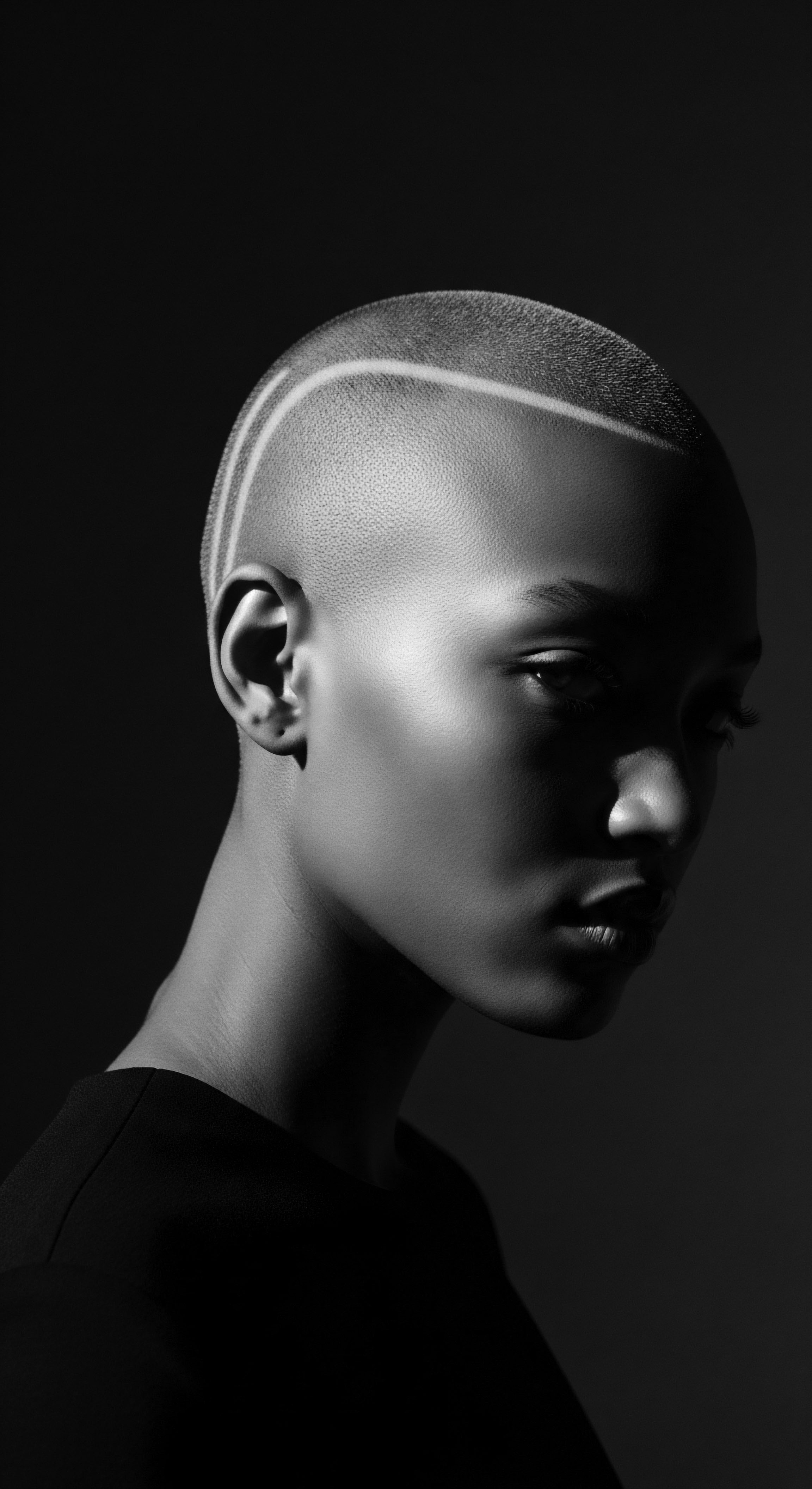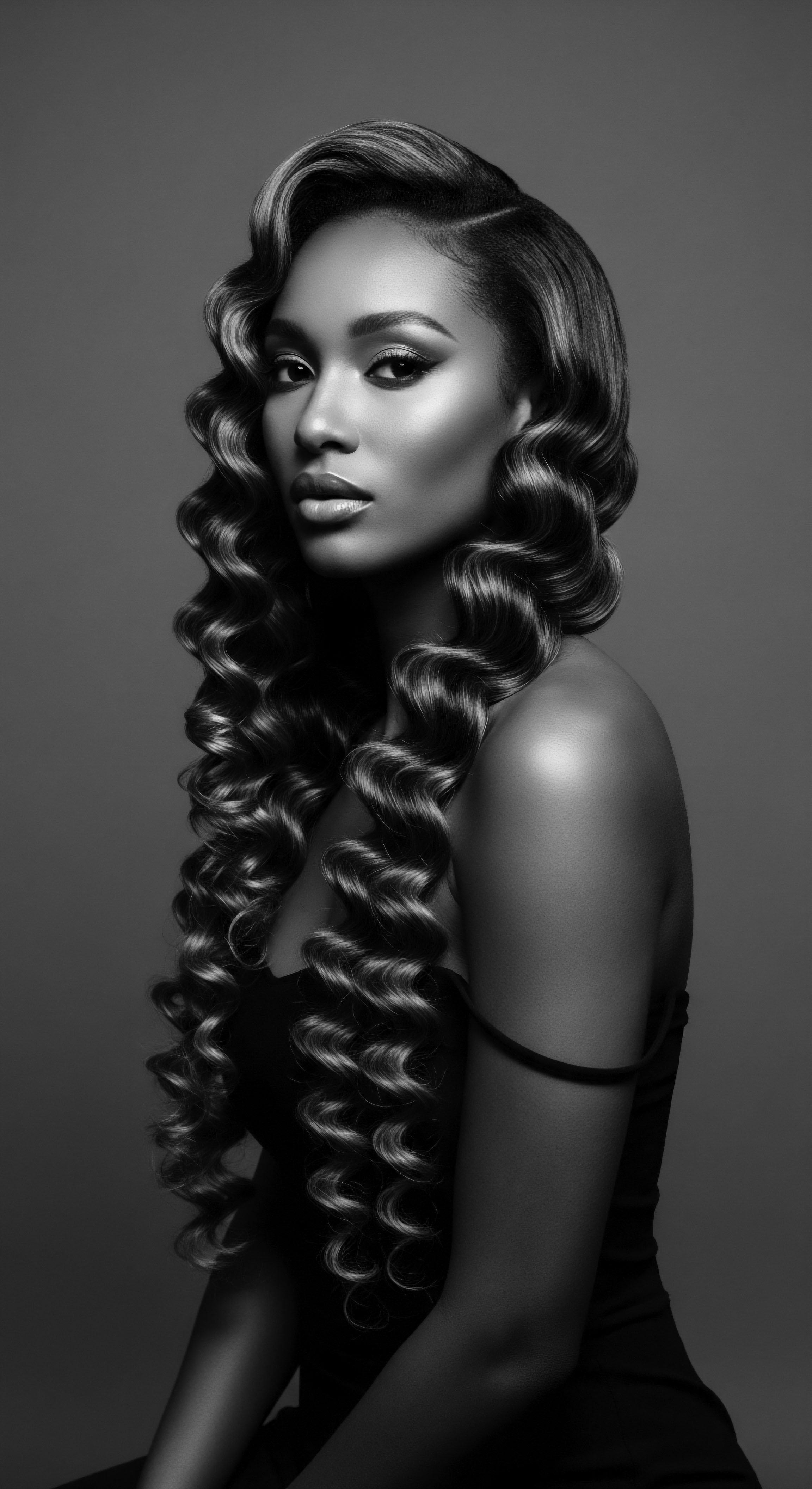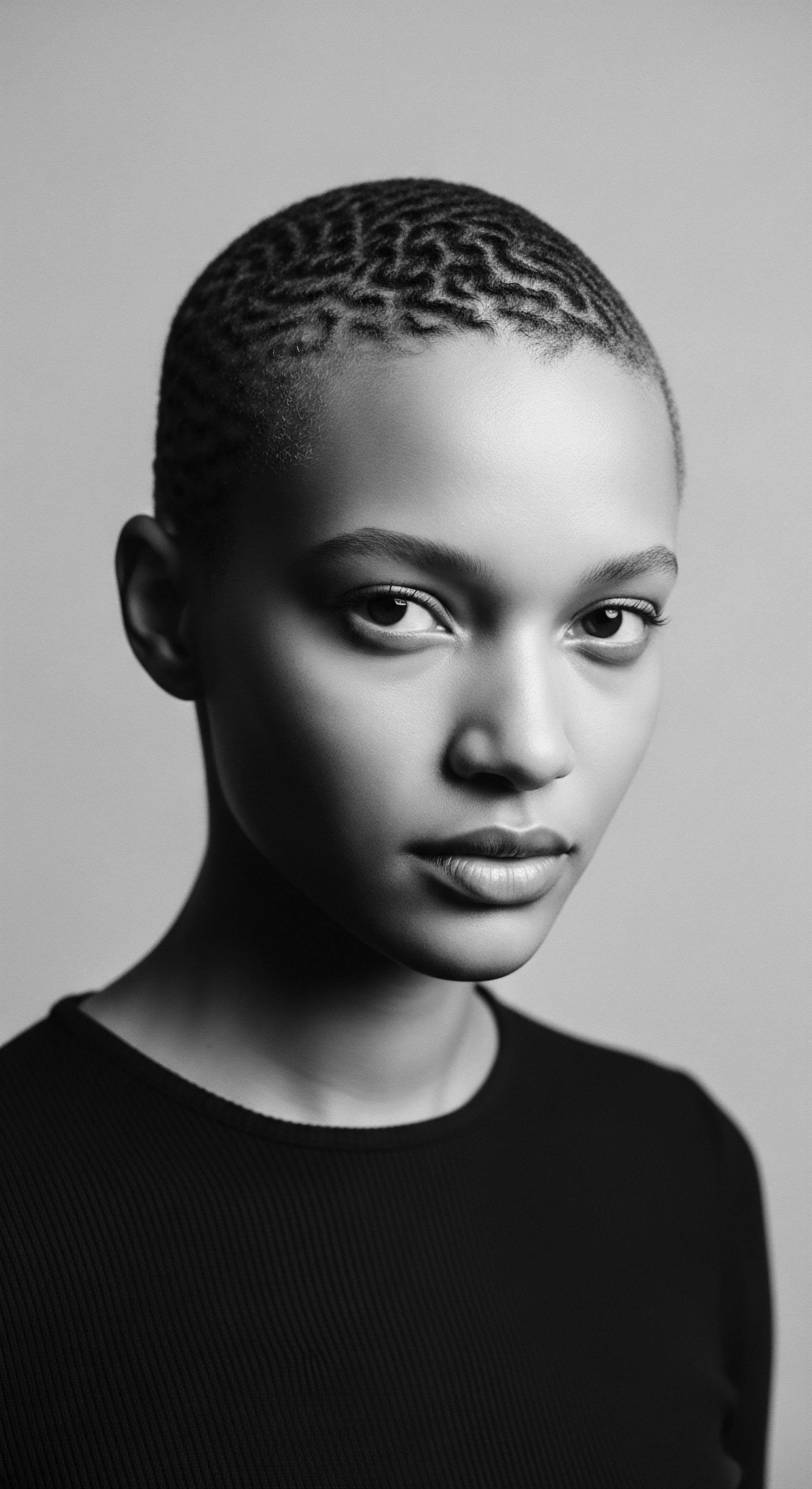
Roots
Consider, for a moment, the hair that crowns the head, not merely as strands of protein, but as living echoes of a past stretching back through generations. For those whose ancestry traces through the intricate pathways of Black and mixed-race experience, hair holds stories, resilience, and a deep connection to the earth’s bounty. The long-standing practice of applying plant oils to textured hair stands as a testament to ancestral wisdom, a tradition rooted in deep observational understanding of hair’s needs.
Modern science, through its rigorous methodologies, now offers compelling corroboration, drawing lines between ancient customs and contemporary biochemical insights. We turn our attention to how today’s laboratories confirm what communal wisdom preserved for centuries, validating the historical use of plant oils in textured hair’s heritage.

The Hair’s Intrinsic Structure and Its Ancestral Care
Textured hair, with its unique helical twists and turns, often presents a greater propensity for dryness and breakage compared to straighter hair types. This structural characteristic, shaped by millennia of evolution, arises from the way the hair shaft itself is formed. The outermost layer, the Cuticle, composed of overlapping scales, functions as a protective shield. In coiled patterns, these scales can lift more readily, creating pathways for moisture loss and rendering the inner Cortex more vulnerable.
Ancient practitioners, without access to electron microscopes, intuitively understood this susceptibility. Their solutions centered on plant oils, a practice seen across diverse African and diasporic communities.
From West Africa, the long-held usage of Shea Butter (Vitellaria paradoxa) stands as a prime instance. This rich butter, extracted from the nuts of the shea tree, was revered for its moisturizing and protective qualities, often used to shield hair from environmental elements. Similar practices extended to the application of Coconut Oil, particularly in regions where the coconut palm flourished. These applications addressed the observable dryness, seeking to impart softness and pliability.
Modern scientific methods increasingly reveal how ancestral plant oil customs meet the specific needs of textured hair.

Modern Lens on Historical Practice
Today’s scientific instruments permit us to inspect hair at a molecular level, offering tangible reasons for the observed benefits. Techniques such as Matrix-Assisted Laser Desorption Ionization Time-Of-Flight Mass Spectrometry (MALDI-TOF MS), combined with mechanical testing, allow scientists to observe how oil molecules interact with and even penetrate the hair fiber. Research indicates that certain plant oils, particularly those with smaller molecular weights and specific fatty acid compositions, can move beyond the surface of the cuticle and enter the hair’s cortex.
Consider the research on coconut oil. Its dominance in traditional hair care is no accident. Studies affirm that coconut oil, with its primary component Lauric Acid, shows a high affinity for hair proteins.
Its relatively low molecular weight and straight chain structure allow it to penetrate the hair shaft, reducing protein loss and water absorption, thereby helping to maintain hair’s integrity. This scientific understanding directly corroborates centuries of communal wisdom that observed coconut oil’s protective qualities.
| Plant Oil Origin Coconut Oil (Cocos nucifera) |
| Historical Use for Textured Hair Long used across African and Indian communities for moisture, protein retention, and overall hair health. |
| Modern Scientific Validation Lauric acid content allows penetration of hair shaft, reducing protein loss and water absorption, strengthening strands. |
| Plant Oil Origin Shea Butter (Vitellaria paradoxa) |
| Historical Use for Textured Hair Traditional in West Africa for moisturizing skin and hair, offering protection against sun and environmental elements. |
| Modern Scientific Validation Rich in fatty acids and vitamins, providing deep moisturization, helping to seal the cuticle and reduce dryness. |
| Plant Oil Origin Castor Oil (Ricinus communis) |
| Historical Use for Textured Hair Applied in ancient Egypt and African diasporic practices for conditioning and perceived growth support. |
| Modern Scientific Validation High ricinoleic acid content supports scalp health, providing moisture and aiding in combating microbial issues, though direct growth claims are less substantiated. |
| Plant Oil Origin These oils, long part of hair heritage, now have their effects explained by contemporary scientific analysis. |

What Unique Characteristics of Textured Hair Benefit from Ancient Oil Practices?
The morphology of textured hair presents distinct challenges, yet these very characteristics are met by the properties of plant oils. The numerous twists and turns along the hair shaft create points of weakness where the cuticle layers can lift, leading to increased porosity and a propensity for dryness. Oils, particularly those that penetrate or form a cohesive film, address these issues directly.
They act as emollients, softening the hair and increasing its pliability, making it less prone to breakage when manipulated. The traditional emphasis on oiling before styling, or as a regular conditioning measure, directly countered the hair’s natural tendency towards dehydration and fragility.

Ritual
Hair care, particularly within textured hair heritage, has rarely been a solitary act; it has always been a communal ritual, a shared experience passing knowledge from elder to youth. The application of plant oils was not merely a cosmetic step. It was a moment of connection, a silent language spoken through hands, a way of upholding collective identity and preserving cultural continuity. The scientific lens, in its validation, also acknowledges the efficacy of these communal practices, showing how the art of hair care was deeply intertwined with practical benefits.

The Hands That Applied, The Knowledge Imparted
Generations ago, within African communities and across the diaspora, hair oiling was often a collective activity. Mothers, aunts, and sisters gathered to tend to hair, a practice seen in braiding traditions from Africa to the Caribbean. During these times, oils were applied not just to the hair strands but massaged into the scalp, an act believed to stimulate growth and maintain health.
This oral and practical transmission of knowledge, passed down through touch and observation, ensured the continuity of specific oil choices and their application methods. For enslaved Africans, despite the brutal attempts to strip them of their identity, hair care practices, including the use of available fats and oils, persisted as a vital connection to their heritage and a form of resilience.
Beyond cosmetic application, plant oils in textured hair heritage embody communal bonds and cultural continuity.

Specific Oils and Their Inherited Legacies
The repertoire of oils employed in ancestral practices is vast, each chosen for observed effects. Modern analysis now provides chemical explanations for these traditional preferences.
- Palm Oil and Palm Kernel Oil ❉ Originating from West Africa, these oils have been staples for thousands of years. Palm oil, extracted from the fruit’s fleshy pulp, is rich in carotenoids and palmitic acid, making it a viscous, protective oil. Palm kernel oil, from the seed, has a higher lauric acid content, similar to coconut oil, offering notable antimicrobial properties and assisting in the delivery of other hair growth treatments. Historically, it was used for skin and hair care, valued for maintaining collagen, strengthening hair, and reducing hair loss.
- Jojoba Oil (Simmondsia chinensis) ❉ While its origins are in North America, its properties resonated deeply with Black beauty traditions, particularly during the “Black is Beautiful” movement of the 1970s. Modern research confirms its unique structure as a Liquid Wax Ester, closely resembling the natural sebum produced by the scalp. This similarity allows it to effectively moisturize and balance the scalp, forming a protective layer that reduces moisture loss and improves hair health. This scientific understanding validates its historical acceptance for addressing dryness and breakage in textured hair.
- Castor Oil (Ricinus communis) ❉ A thick, viscous oil with a long history of use, dating back to ancient Egypt. It was applied for its moisturizing properties and perceived ability to condition and strengthen hair. Modern studies suggest its benefits come primarily from its high ricinoleic acid content, which can improve scalp health, provide moisture, and potentially aid in combating microbial issues. While direct evidence for significant hair growth stimulation remains limited, its role in creating a healthy scalp environment indirectly supports hair vitality.

How Did Ancestral Oiling Traditions Shape Collective Identity?
Beyond the physiological benefits, the communal act of oiling and styling hair reinforced social structures and identity within communities. Hairstyles often signaled tribal affiliation, social status, marital status, and even spiritual beliefs in African cultures. The very act of preparing and applying oils, often homemade mixtures passed down through families, fostered a sense of shared purpose and belonging.
This practice became a form of non-verbal communication, preserving cultural heritage even in the face of forced displacement and cultural erasure, as seen during the transatlantic slave trade. Oils were not merely conditioners; they were conduits of tradition, silent witnesses to endurance and collective self-expression.

Relay
The relay of wisdom across generations, from the ancient use of botanical extracts to our current understanding of their properties, forms a continuous chain of knowledge. Contemporary research does not dismiss traditional practices. Instead, it offers precise molecular and biomechanical explanations for what our ancestors understood through observation and experience. The interplay of plant oils with textured hair’s complex structure and its scalp environment reveals a sophisticated interplay of chemistry and biology, echoing the very insights held by those who first worked with these natural materials.

The Biomechanics of Hair and Oil Interactions
Textured hair, due to its characteristic twists, experiences points of stress where the outer cuticle layers are prone to lifting. This vulnerability leads to increased porosity, causing hair to gain and lose water rapidly, a phenomenon sometimes called hygral fatigue. Plant oils, by forming a protective lipid layer on the hair surface and, in some cases, penetrating the hair shaft, mitigate this. Research indicates that oils like coconut oil reduce the amount of water hair absorbs, thereby lessening the stress of swelling and contraction during washing and drying cycles.
A study investigating the penetration abilities of various vegetable oils into textured hair fibers revealed that while oils like argan, avocado, and coconut oil do penetrate the hair cortex, their impact on mechanical properties varies. For instance, in virgin hair, Coconut Oil and Avocado Oil increased resistance to fatigue, likely due to a lubricating effect on the outermost portions of the cortex and cuticles. Interestingly, this same study also suggests that external molecules might diffuse less homogeneously into textured hair compared to straight hair due to its unique cortical structure. This highlights the specific needs of textured hair and affirms the targeted nature of ancestral care practices.

What are the Biomechanical Reasons Ancient Oils Fortify Textured Hair?
The strength of textured hair relies on its ability to withstand repeated stretching and bending without breaking. Plant oils contribute to this resilience by affecting several biomechanical aspects.
- Lubrication ❉ Oils reduce friction between individual hair strands and between the hair and external forces (like combs or hands). This “slip” lessens mechanical stress, preventing breakage during styling and manipulation.
- Cuticle Adherence ❉ Oils can help smooth down lifted cuticle scales, creating a more uniform surface. This enhances shine and reduces snagging, which lessens damage.
- Moisture Balance ❉ By minimizing excessive water absorption and retention, oils help maintain the hair’s internal moisture equilibrium. This prevents the cycle of swelling and shrinking that weakens the hair over time.
A notable historical example comes from the women of Chad, who traditionally use a paste containing Chebe Seeds (Croton gratissimus) along with other ingredients like cherry seeds and cloves. This practice, applied to the hair strands rather than the scalp, is believed to strengthen the hair, preventing breakage and allowing for impressive length retention. While direct extensive scientific studies on Chebe are still developing, its traditional use aligns with the principle of strengthening the hair fiber to reduce mechanical failure.
The paste is often used with an oil of choice to aid in its application and to seal in moisture. This underscores the synergistic role of oils in ancestral hair care, often combined with other botanicals or methods to enhance their effects.
| Oil Property Penetration of Hair Shaft |
| Scientific Mechanism Oils with small, straight-chain fatty acids (e.g. lauric acid in coconut oil) enter the cortex, reducing protein loss and water absorption. |
| Relevance to Textured Hair Heritage Explains how traditional oiling provides deep conditioning, supporting the internal structure of porous textured hair, a long-observed benefit. |
| Oil Property Scalp Health |
| Scientific Mechanism Antimicrobial and anti-inflammatory compounds (e.g. in castor, neem, amla, sesame oil) contribute to a balanced scalp microbiome. |
| Relevance to Textured Hair Heritage Corroborates ancestral practices of scalp massage with oils, understood to promote growth and address scalp irritations, vital for hair retention. |
| Oil Property Surface Protection |
| Scientific Mechanism Oils form a lipid film on the cuticle, reducing friction, increasing shine, and minimizing moisture loss from the surface. |
| Relevance to Textured Hair Heritage Validates the traditional aim of smoothing and protecting hair, seen in the use of thicker butters and oils to enhance appearance and resilience. |
| Oil Property The empirical knowledge of our ancestors now finds scientific parallels, deepening our respect for their care traditions. |

How do Specific Fatty Acids in Plant Oils Impact Hair Porosity and Strength?
The effectiveness of a plant oil on hair is closely tied to its specific fatty acid profile. Hair has a natural hydrophobic surface, meaning it repels water. When hair becomes damaged, this hydrophobicity can lessen, making it overly absorbent. Oils containing saturated fatty acids, such as those rich in lauric acid (like coconut oil), are better at penetrating the hair shaft.
They can help restore the hair’s natural hydrophobic character, preventing excessive swelling and subsequent damage from water absorption. Oils that do not penetrate deeply, such as mineral oil, primarily form a surface film, which still offers benefits like reduced friction and increased gloss, but lacks the internal strengthening provided by penetrating oils. This biochemical specificity gives a clear basis for the diverse uses of oils within textured hair heritage, where different oils were likely chosen for different needs and hair types.

Reflection
The journey from ancient wisdom to contemporary scientific understanding, concerning the use of plant oils in textured hair heritage, underscores a profound truth ❉ the past offers not just anecdotes, but deeply rooted knowledge. Our ancestors, through meticulous observation and generations of practice, discerned the precise emollients and protective agents the earth offered for their unique hair textures. Their methods, steeped in ritual and communal exchange, preserved hair, not simply as a physical attribute, but as a living symbol of identity, artistry, and strength in the face of adversity.
Today’s laboratories, equipped with sophisticated tools, provide the molecular language to explain these ancestral successes. They confirm that oils like coconut, shea, and castor, chosen for centuries, do indeed interact with textured hair in ways that reduce protein loss, enhance moisture retention, soothe the scalp, and fortify the hair fiber. This scientific corroboration elevates historical practices from mere folklore to intelligent botanical application, a testament to human ingenuity. Roothea stands as a living archive, where every strand tells a story, and every drop of oil poured into care is a continuation of an unbroken lineage of deep understanding and enduring beauty.

References
- Keis, K. et al. “Effect of Oil Films on Moisture Vapour Absorption on Human Hair.” Journal of Cosmetic Science, 2005.
- Marsh, J. M. & Simmonds, M. S. J. “Rooted in Nature ❉ Botanicals for Hair and Responsibly Sourcing Them.” Cosmetics & Toiletries, 2019.
- Phong, M. et al. “Coconut, Castor, and Argan Oil for Hair in Skin of Color Patients ❉ A Systematic Review.” Journal of Drugs in Dermatology, 2022.
- Lourenço, C. et al. “Penetration of Vegetable Oils into Textured Hair Fibers ❉ Integrating Molecular Matrix Assisted Laser Desorption Ioni-Zation Time-of-Flight Mass Spectroscopy (MALDI TOF/TOF MS) Analysis with Mechanical Measurements.” Cosmetics, 2024.
- Ramachandran, R. et al. “Hair Oils ❉ Indigenous Knowledge Revisited.” International Journal of Trichology, 2017.
- Watson, K. et al. “Hair Care Practices from the Diaspora ❉ A Look at Africa, America, and Europe.” Cosmetics & Toiletries, 2025.
- Jostylin Naturals. “Palm Oil vs. Batana Oil ❉ What’s the Difference?” Jostylin Naturals Blog, 2025.
- New Directions Aromatics. “Red Palm Oil & Palm Kernel Oil – For Hair Care & Skin Care.” New Directions Aromatics Website, 2017.
- Ache Moussa. “Ancestral hair-paste ritual gains new life in Chad.” Premium Beauty News, 2024.
- Odele Beauty. “6 Things Everyone Should Know About Black Hair History.” Odele Beauty Blog, 2021.
- BeautyMatter. “The Untold Story of Jojoba Oil in Black Beauty.” BeautyMatter Website, 2025.
- City Skin Clinic. “Castor Oil for Hair Growth ❉ Does it Really Work?” City Skin Clinic Blog, 2024.
- Medical News Today. “Castor oil for hair ❉ Benefits, uses, and more.” Medical News Today Website, 2025.
- NappilyNigerianGirl. “Revisiting the Word Sealing in Natural Hair Care.” NappilyNigerianGirl Blog, 2020.
- Satthwa. “The science behind hair oils ❉ How they nourish and strengthen your hair.” Satthwa Website, 2024.
